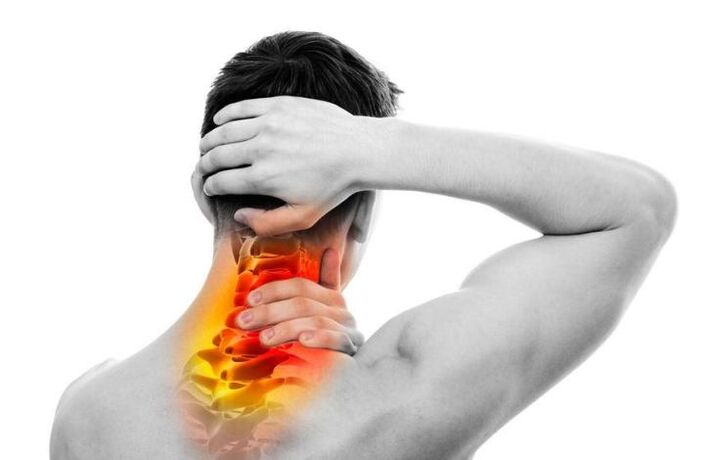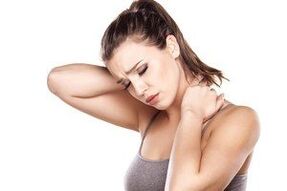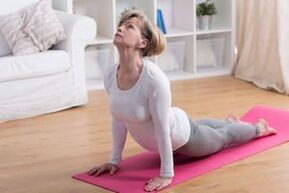Osteochondrosis is a disease in which the vertebrae are damaged, resulting in compression of the intervertebral discs. This leads to pain from pinched nerve fibers. Restricted blood flow leads to disruption of the internal organs. When this disease manifests itself in the cervical spine, it affects the blood supply to the soft tissues of the head and brain, disrupting the transmission of nerve impulses to the central nervous system.
Why does cervical osteochondrosis occur?

This condition can be caused by:
- Hereditary predisposition to a decrease in the volume of the intervertebral disc.
- Back, neck or limb injuries.
- Weakening of the skeletal muscles.
- Difficult working conditions.
- Improper or excessive strength training.
- infectious diseases.
- Shoes that cause gait changes, which increases stress on the spine.
- Unbalanced diet.
- Genetic Diseases.
Most of the causes that produce cervical osteochondrosis and its symptoms can be prevented.It is necessary to create the right working conditions and choose physical activities that will strengthen the muscles that support the spine. However, this is not always possible in a timely manner, since a person rarely thinks about a problem that does not already exist. Therefore, you need to know what are the most common signs of osteochondrosis of the neck:
- reduced range of motion;
- constant or throbbing pain;
- cracking of the vertebrae when moving the head;
- headaches that don't go away with medication;
- numbness of one or more limbs;
- trembling of the limbs or involuntary muscle contraction;
- dizziness, loss of movement or consciousness;
- tinnitus (ringing or squeaking in the ears);
- problems remembering or using learned information;
- loss of memories;
- Problems with the work of the sphincters of the rectum and bladder neck.
Each osteochondrosis of the neck is unique and affects different bodily functions, so some of the symptoms may be absent. But patients always have difficulty turning their heads, pain, and when the condition worsens, headaches and dizziness.
How to determine the disease at home

Pain from osteochondrosis can be both pulsating, short-term and long-lasting, constantly bothering a person. When the neck is affected, the discomfort extends to the shoulder girdle and is mostly localized on the side of the working arm. In this case, the pain can occur both in the neck and between the shoulder blades and can affect the entire arm.
The complexity of the diagnosis arises from the fact that complaints can change over time due to changes in body position, stress or other reasons. Therefore, the first signs of osteochondrosis can be attributed to overuse or muscle strain. But over time, bouts of pain and stiffness become more frequent and intense, requiring identification of the cause and initiation of treatment.
It is quite difficult to independently determine the cause of pain in cervical osteochondrosis at home.In order for the suspicion of osteochondrosis to be justified, it is necessary to rule out other options. Pain is mostly caused by muscle tension, poor posture during sleep or at work. Therefore, it is necessary to improve these conditions in order to understand whether they are the main cause of unpleasant sensations.
If the problems with the throat persist, this is a serious symptom that can speak of both osteochondrosis and other diseases, such as:
- tumors;
- infections;
- Compression of the nerve roots.
Therefore, you should consult a doctor and take an X-ray. This way you will know if there are any injuries or other signs of external influence.
After it became known that the neck was affected by osteochondrosis, regardless of the methods of obtaining information, it is still unclear what caused the disease. You can only independently determine the violation of working conditions, current loads and injuries. The rest of the diseases can only be detected after a full examination - this is necessary, since an infection affecting the spine or similar diseases pose a serious threat to health and life.
How to treat osteochondrosis with medicines and folk remedies
After making a diagnosis, you should adopt a treatment plan that the doctor develops, or create one yourself. When choosing its points, it is important to emphasize an integrated approach to the choice of means and the systematic implementation of all recommendations.
What to do with osteochondrosis of the cervical spine:
- apply medication;
- use folk remedies;
- conduct physical therapy;
- Lifestyle changes to address the underlying cause of the disease.
Medications include:
- Oral and topical preparations that relieve pain and reduce inflammation but do not contain steroid substances.
- Pain relievers that contain corticosteroids.
- muscle relaxants.
- Antidepressants (when the work of the central nervous system is impaired, which has led to a violation of the emotional background).
- Anti-inflammatory ointments.
- Patches for pain relief.
Folk methods include:
- Herbal decoctions and infusions used orally. The effect of the funds depends on the raw materials used. These can be both general strengthening compounds that saturate the body with useful substances, and painkillers or anti-inflammatory drugs.
- Compresses - most often warming to relieve spasms in the neck muscles and allow the spine to return to its original position.
- Rubbing - rubbing folk remedies into the skin, often combined with massage or self-massage. It has a different direction of action, but is most often used to relieve pain, warming and relaxing muscles.

Physiotherapy includes:
- Massage performed by a doctor - medical procedures have a beneficial effect on the spine and back muscles. With injuries in the neck, you can not use the services of a massage therapist who specializes in conducting only relaxation sessions.
- Self-massage - correctly performed actions will help warm up the neck muscles, relieve spasms, restore blood circulation in the neck and shoulder region.
- Improving working conditions, choosing the right furniture to maintain the correct posture, and with sedentary work - frequent breaks during which physical movements are performed.
- Increasing the number of walks, using shoes with shock-absorbing soles. Walking helps to properly load the back, especially the lumbar region, which removes the clamps in the skeletal muscles and returns the spine to the anatomically correct position.
- In the morning, do a warm-up routine that includes both neck and shoulder girdle exercises and other body parts. In this case, all movements are performed using only their own weight, or in rare cases, light dumbbells are allowed.
- Sauna or bath – a visit to the steam bath with a cure of 10-12 times can significantly relieve tension in the back muscles and activate the body's metabolic processes.
- Procedures prescribed by a doctor and performed with the help of special equipment (electrophoresis, etc. ).
In addition, swimming in the pool is a great way to maintain optimal muscle tone, relieve spasms and eliminate atrophy. This needs to be done constantly and should be started as soon as the inflammation stops. During the first visits, the shoulder girdle should be moderately loaded, after which it should be gradually increased until swimming becomes a full-fledged workout.
Subject to the doctor's recommendations, remission occurs quickly enough if the disease has not turned into a moderate or severe form. But it's important to remember that even the complete disappearance of symptoms is not a sign of a cure.

















































